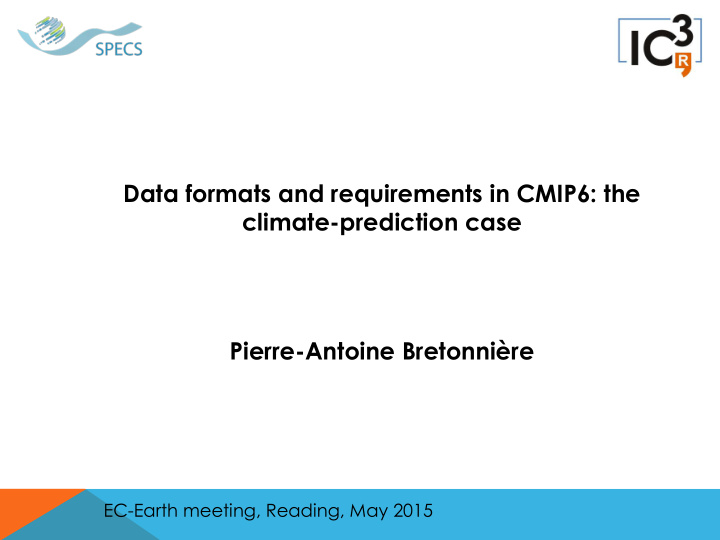



Data formats and requirements in CMIP6: the climate-prediction case Pierre-Antoine Bretonnière EC-Earth meeting, Reading, May 2015
I – Experience from previous Model Intercomparison Projects CMIP5 – SPECS – II – How to comply with strict metadata and format conventions A CMOR history – Plans for CMIP6 – EC-Earth meeting, Reading, May 2015
Experience from CMIP5 ● 1.8PB for 59000 data sets stored in 4.3Mio Files in 23 data nodes, 116 experiments published. (=CMIP3x50) ● NetCDF3 format tas_Amon_EC-Earth_historical_r1i1p1_185001-200512.nc ● Triple data quality control: ESGF publisher conformance checks, Data consistency checks, ‐ Double and cross checks of data and metadata and DataCite data publication ● Experience and model description shared before data publication (ES-DOC database) EC-Earth meeting, Reading, May 2015
Experience from CMIP5 Lessons and future requirements: ● Usability of ESGF data access interface ● Automated data replication between ESGF data nodes ● More powerful, more stable and scalable wide area data networks (service level agreements) ● Detailed information of initialization, physics, etc should be more easily accessible (were in the model documentation) EC-Earth meeting, Reading, May 2015 4
Experience from SPECS ● 80 TB of data, being stored at the BADC and published on the ESGF nodes ● NetCDF4 format (1.5 to 2x space saving) ● Double time axis to encode seasonal to decadal predictions ● Add start date in the name of the file IPSL-CM5A- LR/decadal/S19890101/mon/ocean/tos/r3i1p1/tos_Omon_IPSL- CM5A-LR_decadal_S19890101_r3i1p1_198901-199812.nc ● New attributes: ● initialization and physics description ● associated experiment ● Creation of “deposit receipts” when data is published EC-Earth meeting, Reading, May 2015
CMOR history ● CMOR is a library of C functions ( with Fortran90 and Python interfaces) which facilitate/enforce compliance with MIP requirements . ● CMOR was designed to be adapted to the different metadata requirements of each “model inter- comparison project” ● CMOR2 has been used in CMIP5, and a SPECS patch to encode new requirements and project specific conventions was developed. EC-Earth meeting, Reading, May 2015
CMOR history ● Ensures compliance with: ● NetCDF – (www.unidata.ucar.edu/software/netcdf/ ) ● CF Conventions (provides standardized description of data contained in a file ( cf-convention.github.io ) ● Data Reference Syntax (DRS) – defines vocabulary used in uniquely identifying MIP datasets and specifying file and directory names ( cmip-pcmdi.llnl.gov/cmip5/output_req.html ). Project specific EC-Earth meeting, Reading, May 2015
Plans for CMIP6 The CMOR library will be used to ensure that all the data ● produced by the different partners have the same standardized format CMOR3 is under development to: ● Better handle a wide range of models and observational – data Modularize CMOR input tables – Integrate CMIP6 format conventions changes (including – SPECS standards) New format and DRS under development ● Data quality control handled at several levels (improved in the ● CMORization process itself: e.g., valid max and min for each field) EC-Earth meeting, Reading, May 2015
Plans for CMIP6 SPECS contribution to CMOR will ● ensure that the needs of the Decadal Climate Prediction Project are taken into account For EC-Earth users, unifying the ● data formatting (using tools like ece2cmor) in CMIP6 will ensure better efficiency in the CMORization Use of XIOS to facilitate the ● formatting of the data ESGF nodes and EC-Earth users map EC-Earth meeting, Reading, May 2015
Thanks for your attention! Questions?
Recommend
More recommend